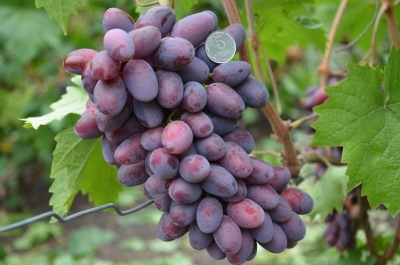
- Authors: Pavlovsky Evgeny Georgievich
- Appointment: dining room
- Berry color: deep purple with burgundy tint
- Taste: harmonious
- Ripening period: early
- Ripening period, days: 100–105
- Frost resistance, ° C: -23
- Name synonyms: B-9-2
- Bunch weight, g: 1000–1500
- Flower type: bisexual
The etalon is a table grape variety bred specifically for cultivation in cold regions. In a short time, the variety won the love of Russian winegrowers, who highly appreciated its taste and unpretentious care.
Breeding history
The standard was developed by the breeder Evgeny Georgievich Pavlovsky. This grape was the result of crossing Krasotka and Talisman varieties.
Description
The bush is distinguished by its great vigor of growth, 2-3 inflorescences are formed on the shoots, the leaves are medium, curly in shape. The plant begins to bear fruit in the third year of life; good ripening is characteristic of the vine.
Ripening period
The standard refers to varieties with an early ripening period. The first berries can be enjoyed 100-105 days after flowering.
Bunches
The bunches have a conical shape, are loose in density, and their weight reaches 1–1.5 kg. Peeling is not typical for this variety.
Berries
The fruits have a dark purple color with a burgundy hue, an elongated oval shape and large size, weighing 8-12 g.
Taste
Taste properties are high. The taste is pleasant, harmonious, the fruit pulp is dense and crispy.
Yield
The standard refers to high-yielding varieties.


Growing features
Consider several factors when maintaining a variety.
- Before and after the flowering period, the plant needs abundant watering. Each bush needs 7-9 liters of water at a time.
- In the first year of fruiting, it is recommended to leave only one bunch for the shoot. In an unfavorable year, even more intensive thinning is allowed. This technique will make it possible to get a healthy strong plant for the next year;
- In early spring, it is required to tie up the vines until the leaves and shoots have formed, so as not to damage the bud's eyes.
- In the first year of keeping the crop, you need to regularly loosen the soil so that the root system receives enough oxygen.
- The standard needs fertilization 3-4 times per season, young bushes can be fed up to 6 times. Compost and potassium-phosphorus compounds can be used as additional food.
Landing
Plant your grapes following specific steps.
- Dig holes measuring 70x70cm. The distance between specimens is 2 m.
- Organize drainage at the bottom (expanded clay, crushed stone).
- The next layer is followed by fertilizers, for example, mixtures containing potassium and phosphorus, as well as organic fertilizers (mullein, chicken droppings, compost).
- Wait for the earth to settle, then mix the garden soil with organic matter and apply with the next layer.
- The day before planting, hold the seedling in water, process it in a growth stimulator and plant it in a mound made in the center of the hole. Spread out the roots.
- Cover the soil so that the root collar is not hidden.
- Water the planting site with 10 liters of water and tie the cutting to a peg.
- Cover the seedling with a cut bottle, compact and mulch the root zone.

Pollination
The type of flower of the Etalon variety is bisexual, which means that it has excellent self-pollination properties, so the bush will not need additional pollinating varieties.
Pruning
If the cuttings are tall, then they are cut off after 7 eyes. If the sprouts are of medium and small stature, then they are cut off after 5 eyes. It is important to systematically carry out the formation of the plant, this will ensure the production of large berries.



Frost resistance and the need for shelter
The standard tolerates temperatures down to -23 °. If the plant is planted in the southern region, then winter protection is not needed. In the case of growing in the middle lane and northern regions, you need to take care of the warming of the culture. A special tub or dense polyethylene folded in several layers can be used as a shelter.

Diseases and pests
Wasps are not terrible for the Etalon variety. This variety is not particularly susceptible to such ailments as rot, oidium, mildew, but when kept in the northern regions, it can be affected by them. As a preventive measure, thin out the bunches, and also treat with special means.

If a grape is exposed to any disease or insect, this always affects its appearance.
Storage
Due to the dense pulp, the fruits can be stored for a long time and retain their presentation. For storage, the bunches are folded into wooden boxes and removed to the cellar. The berries of the presented variety tolerate transportation well.











































































